Case Study
Nippon Medical School
Implementing 46 BIG PAD units to enrich small-group learning
Helping to improve students’ diagnosis abilities and communication skills

(top)Stimulating discussions take place while writing directly on materials
(bottom)36 units were simultaneously implemented into all classrooms for small-group learning
University
Increased efficiency, Improved service, Improved image
PN-L703W (70-inch) x 36 units
PN-L803C (80-inch) x 10 units
BIG PAD units were implemented at the Sendagi Campus (Bunkyo City) and Musashisakai Campus (Musashino City) in March 2016. 36 70-inch models were installed in the classrooms for small-group learning, and 10 80-inch models were installed in the faculty meeting rooms, etc.

Bunkyo City, Tokyo, Japan
Founded in 1876. Japan’ s top-class private medical university has celebrated its 140th anniversary. Nippon Medical School provides high-quality education in a well-equipped environment and strives to train doctors
with a rich sense of humanity. World-renowned bacteriologist, Hideyo Noguchi, is an alumni.
Our university focuses on small-group learning. Students take the initiative in discussing the issues presented to them, rather than being led by teachers. We had been using whiteboards and monitors, but we wanted to implement new equipment to facilitate discussions and enhance content.
- Notes can be written on materials/images and saved. Discussions from the previous sessions can be continued smoothly.
- Students have active discussions. The written data is saved, making it easier for teachers to evaluate the students.
- Images such as X-ray pictures can be displayed clearly on the large screen. This helps the students improve their image diagnosis abilities.
Our university focuses on small-group learning (SGL), a curriculum style in which students take the initiative to learn instead of being led by the teachers. With SGL, the students start discussions on symptoms presented by the teacher during the first session. From the second session, the students discuss newly introduced X-ray images or data they have brought. The students identify the name of the illness in the fourth session. We thought that enhancing the contents of this SGL would help the students improve their diagnosis abilities and increase their assertiveness and communication skills.

Nippon Medical School
(left)Akihiko Gemma
President,
Nippon Medical School
(right)Yasuhiko Ito
Education Manager
Professor, Department of Pediatrics
and Adolescent Medicine
In the past, we used whiteboards and 42-inch monitors for the classes. However, notes could not be written on the displayed materials, and the discussion process could not be recorded. BIG PAD allows the students to write directly on the displayed material. In addition, teachers can refer to the written data when checking learning details at a later date. This helps them give a more accurate evaluation.

Small-group learning using BIG PAD
BIG PAD units were implemented in all SGL classrooms to improve the learning environment and allow students to take the initiative in solving problems. By displaying documents and images on the BIG PAD, teams can discuss them while writing on the materials. This deepens communication and improves their ability to think on their own. X-rays and other images can be displayed on the large screen, allowing students to view the details and increase their image diagnosis ability. Data written on the screen is saved, so continuous discussions can be held smoothly over four sessions. This system is popular with teachers as they can see the discussion process and quickly evaluate the students.

Used at open campus to hold mock lessons for prospective students
The information discussed during SGL can be saved and shared with other groups, further enriching the students’ learning experience. BIG PAD can also be connected wirelessly with the students’ laptops or tablets, increasing the range of use. We hope that implementing this state-of-the-art equipment will promote our university’s innovative spirit.

Installed at free spaces where students can freely exchange opinions
Issued September 2016
